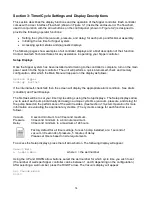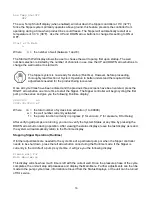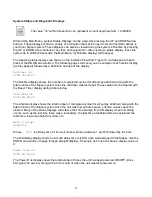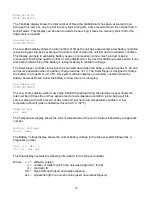
5
During the vacuum timer cycle, vacuum is applied to the air line tubing, stainless steel pump, and
intake; helping the product to flow through the oleophilic/hydrophobic mesh screen and into the pump
cavity. When the programmed vacuum time expires, the system initiates the pressure timer cycle.
During the pressure timer cycle, air is compressed into the air line tubing, evacuating the product from
the pump. Once the programmed pressure time has expired, the compressor shuts down and the
system initiates the programmed delay timer. Upon expiration of the delay timer, the process is
repeated.
On multiple channel Sippers the vacuum, pressure, and delay cycles are set individually per well. This
accommodates recharge and recovery rates unique to individual wells on the same site. A variety of
timer setups can be implemented to maximize recovery. For example: different wells can be pumped
more or less often than others to maximize recovery. The programming prioritizes the pumps so one
pump is operational at a time.
The Sipper controller has several feedback data recording mechanisms that can be used to gauge
effectiveness of the remediation system. Two cycle counter screens are available, one records the total
lifetime cycles of the controller, the other counter is resettable by the user for monitoring purposes.
These cycle counts can be compared with total recovered fluid to determine how much fluid is being
recovered per pump cycle. There is also a runtime clock which only increments when the battery is
charged and when the system is operating. This clock can be compared with actual recorded
deployment time to determine if more solar panels are required to keep the system running. More on
this can be found in
Section 6: System Troubleshooting
of this manual.
The Solar Sipper Controller is dependent upon the annual average solar resources, which can vary
from region to region. Geotech assists in determining how much potential recovery can be expected
depending on where the site is and how many solar panels will be required. More information about
solar panel location can be found in
Section 2: System Installation.
Recovery Rates
The available solar energy and number of solar panels will determine how quickly available product can
potentially be recovered. Recovery will ultimately be limited by the recharge rate of the product layer in
the well. Repeatedly removing the entire product layer can reduce fluid conductivity to the well and in
turn reduce recovery rates overall.
When the product layer is completely depleted, air is invited into the well screen and surrounding sub
surface soil or strata. This air can act to block fluid conductivity as well as to promote bacteria growth
and breakdown of the product being recovered. This
will eventually ‘clog’ the fluid path to the well and
so reduce the product layer recharge rate. Geotech recommends recovering smaller amounts of
product more frequently. This will promote continued fluid conductivity to the well.
In the event that the intake screen, discharge line or check valve should get blocked, remove the
Skimmer and clean the intake cartridge and connections as described within the System Maintenance
Section of the Geotech Pump and Skimmer Assembly Manual.
Geotech offers a variety of tools and training to provide you with information on properly maintaining
your Sipper system and on obtaining a recharge rate. Contact Geotech to discuss your specific
application in detail.
Summary of Contents for Solar Sipper
Page 1: ...Rev 10 12 2017 Part 16550176 Geotech Sipper Installation and Operation Manual...
Page 2: ...i...
Page 16: ...13 Figure 2 5 Example of Tankfull Probe...
Page 23: ...20 Figure 3 1 Flowchart of User Interface Label...
Page 24: ...21 Figure 3 2 Example of Solar Sipper front panel...
Page 38: ...35 Section 8 System Schematics Figure 8 1 Solar Sipper Schematic...
Page 39: ...36 Figure 8 2 AC Sipper Schematic shown with optional Desiccant Dryers...
Page 40: ...37 Figure 8 3 8 Well Solar Sipper Internal Wiring Diagram...
Page 41: ...38 Figure 8 4 3 Well Solar Sipper Internal Wiring Diagram...
Page 45: ...42 Notes...









































